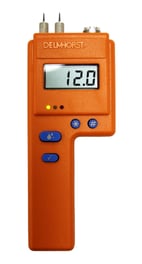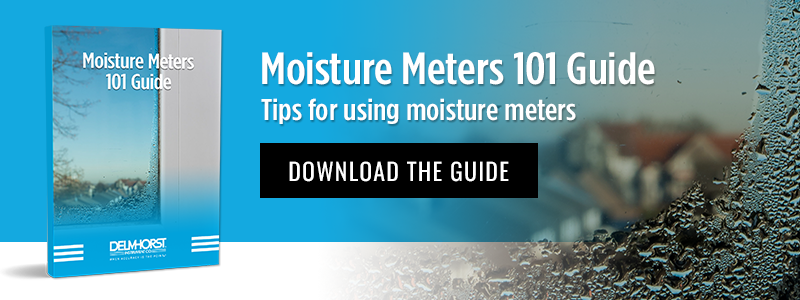Drywall is incredibly sensitive to moisture. Just a tiny amount of moisture—as little as just over 1% moisture content—can cause drywall to severely degrade. If the moisture is removed quickly enough, the damage to the drywall can be contained to a small area.
Here, being able to quickly and accurately detect and measure the moisture content (%MC) of drywall is crucial for spotting the slight moisture contamination that may not be discernible to the naked eye, but is still severe enough to damage the drywall.
A few things to keep in mind when using a moisture meter for drywall include:
Choosing the Right Moisture Meter
 The first step in using a moisture meter on drywall is picking the right moisture testing device. When choosing a device to test moisture in drywall, look for the following:
The first step in using a moisture meter on drywall is picking the right moisture testing device. When choosing a device to test moisture in drywall, look for the following:
- A Gypsum/Drywall Reading Scale. To get the most accurate readings, you need a device that is calibrated to get readings in gypsum.
- Measurement Range. Because of how vulnerable drywall is to moisture, the meter needs to be able to accurately measure moisture at very low %MC levels. For example, the gypsum scale on the BD-2100 can measure moisture over the range of 0.2% to 50% MC.
This will help you find the best moisture meter for checking the %MC of drywall (and other gypsum-based materials). It may be useful to check for other reading scales, such as wood or reference scales to make the meter useful for more than just drywall.
Measuring Moisture with a Drywall Scale Meter
If you have a moisture meter with a gypsum scale (a.k.a. drywall scale), then the process for measuring moisture in drywall is relatively simple: push the pins of the moisture meter into the drywall, and activate the meter.
Should the meter indicate a significant amount of moisture, then extra measurements should be taken at regular intervals around the moisture-compromised area. These measurements should be repeated until you have an indication of the boundaries of the wet wall.
Depending on how wet the wall is, you may be able to dry it off, or you may have to tear out the wet gypsum to keep it from causing further damage to the surrounding area.
Measuring Moisture in Drywall with a Non-Drywall Meter
If you don’t have access to a moisture meter with a drywall scale setting, you may be able to use a reference scale meter to get a qualitative measurement of the moisture in the drywall.
These measurements will just be relative indications of moisture, not precise measurements. However, any major indication of moisture on a reference scale meter could likely be considered a reading of “moisture compromised.” To get an idea of what a dry reading looks like on the reference scale, first take a measurement in a piece of drywall that is known to be dry.
Finding the Source of the Moisture
When checking for moisture in drywall, it’s important to find the source of the moisture and fix the issue quickly to keep the damage from getting worse. After determining where the compromised drywall is and the extent of the water-damaged area, consider where the most likely source of the moisture intrusion is.
For example, if the moisture-compromised drywall is halfway up the wall, but no higher, there may be a burst or leaking pipe behind the drywall. If the moisture-compromised area is strictly along the floor, then there may be a pool of water gathering along the base of the wall. If the moisture goes all the way to the ceiling, then there may be a problem with the roof or with pipes located in the next floor up.
The sooner the source of the moisture can be found and fixed, the better.
Verifying Moisture Meter Accuracy
Because the acceptable moisture content range for moisture in drywall is so narrow (under 1%), it is crucial for the meter in question to be extremely accurate. So, when preparing to start taking moisture measurements, it is important to check the calibration of the meter.
There are two primary methods of testing moisture meter accuracy:
- A Moisture Content Standard (MCS). This is an external device which is designed to provide a set reading value when the meter is used on it. If the measurement is the same as what the MCS is supposed to read, then the meter is accurate.
- Built-in Accuracy Checks. Some devices have a built-in calibration check that allows users to check the meter’s accuracy with the push of a button. This is generally considered the most convenient way to verify meter accuracy.
This can help you avoid getting false positives for moisture content in drywall.
These are the basics of using a moisture meter for drywall checks. For more information about moisture meters in restoration work, check out Delmhorst’s restoration guide at the link below!

Comments